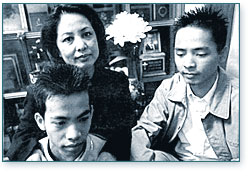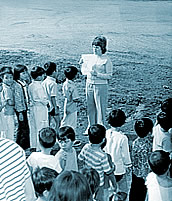|
Continued from page 1
Colleges and Universities
 The story of Southeast Asian Americans in U.S. colleges and universities is
mixed, with some inspiring successes and many continuing struggles. The failure
of most educational institutions to disaggregate “Asian/Asian American”
enrollment and retention data often means that the realities of Southeast Asian
American college students are hidden or distorted within a larger pan-Asian demographic
category. Relative to many other Asian American groups, Southeast Asian American
populations, especially Hmong, Lao, and Cambodian Americans, continue to have
urgent needs for educational equity programs and services. The story of Southeast Asian Americans in U.S. colleges and universities is
mixed, with some inspiring successes and many continuing struggles. The failure
of most educational institutions to disaggregate “Asian/Asian American”
enrollment and retention data often means that the realities of Southeast Asian
American college students are hidden or distorted within a larger pan-Asian demographic
category. Relative to many other Asian American groups, Southeast Asian American
populations, especially Hmong, Lao, and Cambodian Americans, continue to have
urgent needs for educational equity programs and services.
On many college campuses, Southeast Asian American students have formed ethnic
organizations that function as support groups. They plan cultural and social events
and participate in community outreach projects. More Southeast Asian Americans
are entering graduate programs and professionals schools, including many who work
with their ethnic communities upon graduation. A small but growing number of university
faculty conducting research and teaching about Southeast Asian Americans is also
emerging at college campuses across the country.
Students Help Their Families
The children of refugees and immigrants, especially the eldest
children, face immense pressure to do well in school and find
well-paying jobs. They are often reminded of how their parents endured
hardships while growing up and made incredible sacrifices to provide
their children with better prospects in the U.S. Parents therefore
expect their children to excel educationally and professionally.
Members of the younger generation are often forced to select
occupations that will help them support their families rather than
professions of their choice. This is changing as younger generations
are entering non-traditional occupations beyond the medical,
engineering, or computer science fields. As their families become more
financially secure, they have the freedom to pursue other academic and
professional interests. 

|


 The story of Southeast Asian Americans in U.S. colleges and universities is
mixed, with some inspiring successes and many continuing struggles. The failure
of most educational institutions to disaggregate “Asian/Asian American”
enrollment and retention data often means that the realities of Southeast Asian
American college students are hidden or distorted within a larger pan-Asian demographic
category. Relative to many other Asian American groups, Southeast Asian American
populations, especially Hmong, Lao, and Cambodian Americans, continue to have
urgent needs for educational equity programs and services.
The story of Southeast Asian Americans in U.S. colleges and universities is
mixed, with some inspiring successes and many continuing struggles. The failure
of most educational institutions to disaggregate “Asian/Asian American”
enrollment and retention data often means that the realities of Southeast Asian
American college students are hidden or distorted within a larger pan-Asian demographic
category. Relative to many other Asian American groups, Southeast Asian American
populations, especially Hmong, Lao, and Cambodian Americans, continue to have
urgent needs for educational equity programs and services.